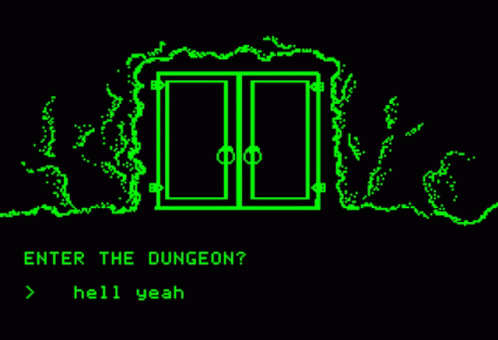A New Year’s Resolution Mechanic
PrismaticWasteland has thrust his challenge upon the writers’ hall: design a new core resolution mechanic and torment your players with the horror of learning! Jokes on you, bud. This torture is reserved for the Referee.
I was chatting about aboard the Stratometaship when Luka mentioned he was drawing a card-based dungeon system. Cards depicting beautiful drawings and evocative names, all laid out neatly amongst each other. That got me a’thinkin.

Resolving a Dungeon
Eschew your heist-ready dungeon blueprints, toss your rulers and protractors, burn your lair floor-plans to be shown to new tenants. Enter: the Dungeon Deck.
- Environs
- Treasure
- Factions
- Bosses
- Chaos!
With these elements, stack them in a Deck and give a good shuffle, like you’re trying to win at a magical Gathering. When first entering the dungeon, draw and lay down three cards. There’s your start. Each time the players explore beyond a known delve, have them draw and lay the card down orthogonally to another card, thus building their own pointcrawl. This puts your party into the driver’s seat and gives them the power to help define the fiction further, taking that strain off you as the Referee. I go into more detail on each card type below.
Environs.
You know what these are: exotic locales or dank crypts to be plundered. Jot down one or three (but not two!) details for each, such as inhabitants, prominent sensory details, and foreshadowing. Bonus XP: ask the players to provide a sensory detail or small event that takes place while they explore.
If you want to take it further, place conditional events in your Environs. If the Crystal Skulls faction card is already in play, then the Crystal Cave stalactites have impaled several poor souls on the ground below. Alternatively, you should consider placing a good Trap within to change the pace of play. The cavern begins to collapse and your heroes need to think quick!
Perhaps these are even your classic empty rooms that serve to advance the Dungeon Clock while providing theme and tactile sensations for the characters. Sloshing about in a muddied chamber, swimming through a pungent sewer, or crunching through hills of bone.
Treasure.
Every adventurer perks up when a bit of gold is thrown at their feet. A swordsman burns for the opportunity to add another blade to his scabbard. An inquisitive techno-wizard sighs relief when she spies an arcano-matrix amplifier…what the hell is that? Anyway! Stack your deck with a few treasure rooms to be found, providing an incentive for staying in the dungeon longer. Be up front with your players. Tell them how many you threw in. The meta-knowledge becomes an additional gameplay lever to pull, affording them the chance to shape further the fiction. Bonus XP for making them conditional. Add a puzzle or riddle to gain entry or place a key in another room in the Deck.
Factions.
If you opt for a more living-dungeon experience, create some Faction cards! Name, leader, and some very brief qualities about them should suffice. If you run a lore-deep campaign or include a larger organization, feel free to sub-divide and create smaller units within that grander hierarchy. Give them a special Trait or quality that sets them apart from their other comrades. Alternatively, grant them some lore to dispense to help tie together the world in an immersive way.
Bosses.
Everyone loves a good boss fight. Building tension and terror amplifies excitement at the table. Jot down one to three Bosses to be encountered and toss them into the deck. Oftentimes, the objective of the Dungeon will be to conquer a specific Boss. If that’s the case, this provides a pseudo-clock for your players. Eventually, they will come to grips with the foe. It is inevitable if they wish to continue delving. For me, the fascinating part is this: Bosses can ambush the party. It turns the dynamic around! It plays the Alien, and you Ripley.
If you pull a Boss early, the players have the opportunity to use their table meta-currency (hero dice, inspiration, etc) to cast it back into the Deck and gain knowledge on it to better prepare themselves for the impending clash. This represents them interacting with the creature’s environment to discover more about them, or perhaps stalking the mighty foe to study their behaviors or biomagical traits. Ahh, the dragon breathes ice!
Bosses can also be innately tied to the Factions in the Deck too! Perhaps once conquered, one of the other factions struggling for control seize the power vacuum. It provides your heroes a visible representation of their effect on the game world as well as a moral conundrum if you play into the dynamics of the roleplay.
Give your other Rooms hints or tools to use in the fight to come against your Boss! Optionally, you can tie the reveal of Treasure rooms not yet discovered to the resolution of Boss cards.
Chaos!
Create connections between two different nodes, discover new entries and exits, have an event completely alter the state of the Dungeon, or have it swap Factions in or out. This is the wildcard!
If you end up not using some cards, worry not! Roll them into the next dungeoncrawl and save yourself some time later.
After all is said and done, I hope someone out there gives it a try and finds success with it. My gut tells me it’s great for learning improvisational play, which is the heart and soul of the OSR. I also reckon it will be a neat way to prep for a session and run procedural dungeons without needing to roll dice and consult tables. Can you think of any Card types I missed? Share with me in the comments below!

Leave a comment